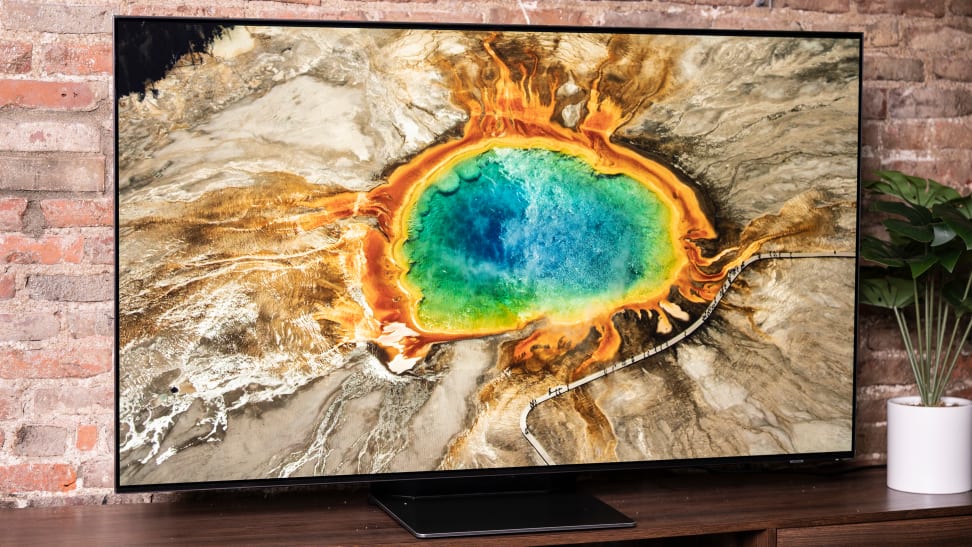Samsung S95B vs Samsung S95C: Is the upgrade worth it?
Is Samsung’s newest OLED better than the last?
 Credit:
Reviewed / Betsey Goldwasser
Credit:
Reviewed / Betsey Goldwasser
Products are chosen independently by our editors. Purchases made through our links may earn us a commission.
If you’re shopping for a new TV and you’ve got the funds for a fantastic, high-end flagship, you might be tempted to slam down your credit card for the latest model. Here’s the rub, though: Many of last year’s best TVs are on sale right now. And I mean really, really on sale.
Such is the case for the Samsung S95B, one of the best TVs we reviewed last year. Its follow-up, the S95C recently hit shelves, and now that the latest version is available for purchase, the S95B has never been cheaper.
The question is whether the newest version of Samsung’s flagship OLED is worth the premium price tag, or if it makes more sense to save a bunch of money on a year-old TV. We’ve spent a good deal of time thinking about this question, and having tested both models extensively, we’re well qualified to help you out. Here’s everything you need to know about these two impressive TVs.
Buy the Samsung S95C at Amazon
Buy the Samsung S95B at Amazon
Price

Both the S95C and S95B come with Samsung's Solar Remote.
Being a year-old TV, the Samsung S95B is currently seeing significant discounts everywhere it’s sold. On Amazon, for example, it’s currently listed for almost half off its original price.
Samsung S95B:
- 55-inch (Samsung QN55S95BAFXZA), MSRP $2,199.99 (on sale for $1,279 at Amazon)
- 65-inch (Samsung QN65S95BAFXZA), MSRP $2,999.99 (on sale for $1,797.99 at Amazon)
Unfortunately, the S95B is only available in two sizes: 55 and 65 inches. At the time of publishing, the 55-inch model is on sale for around $1,300.
Samsung S95C:
- 55-inch (Samsung QN55S95CAFXZA), MSRP $2,499.99
- 65-inch (Samsung QN65S95CAFXZA), MSRP $3,299.99
- 77-inch (Samsung QN77S95CAFXZA), MSRP $4,499.99
The S95C features a third, room-dominating 77-inch option. This is good news for shoppers looking for something bigger than 65 inches. That said, as a new release, you’ll be paying full price for any of these three models. The 55-inch S95C will run you about $2,500—almost twice as much as the 55-inch S95B.
The extra-large size option is sure to satisfy big-screen TV enthusiasts, but in the all-important price category, the winner is last year’s S95B.
Our pick: Samsung S95B
Design

The S95B QD-OLED was the first TV of its kind, blending an OLED display with the power of quantum dots.
The S95B and S95C are very similar in design. Both feature a pedestal-style stand that takes the form of a flat, metallic plate. Each stand offers about three inches of clearance for a soundbar. Additionally, both TVs ship with Samsung’s Solar Cell remote control, which conveniently uses light and radio waves to charge its internal battery.
OLED TVs don’t rely on a traditional backlight, which allows the S95B and S95C to be about as thin as an iPhone. At their thinnest points, both of these TVs are impressively svelte due to their high-end display technology.
The main difference between the design of these two TVs concerns their inputs. While the S95B features a traditional suite of inputs on the back of its chassis, the S95C houses its inputs in a box that can be detached from the entire TV and placed elsewhere nearby. Because the S95B doesn’t use this external box, it’s bulkier around the middle. The S95C is uniformly sized from top to bottom.
When affixed to the S95C, Samsung’s One Connect Box sits neatly and securely on the back of its stand. It comes with two cables that connect the One Connect Box to the TV: a short cable for when the box is attached to the stand and a longer cable for added flexibility.
While both TVs are impressively designed, some people may value the S95C’s uniform look (as well as the added flexibility of Samsung’s One Connect Box) more highly than others.
Our pick: Samsung S95C
Features and smart platform

Samsung's Tizen OS is faster over last year's version, but it's still frustrating to navigate.
Being two versions of the same TV, the S95B and S95C share many of the same hardware- and software-related features. Before I get into what sets them apart, here’s a look at all of the features they share.
- Resolution: 4K (3,840 x 2,160)
- Display type: QD-OLED (OLED + quantum dots)
- HDR support: HDR10+, HDR10, HLG
- Dolby Atmos: Yes, (native decoding)
- eARC support: Yes
- Smart platform: Tizen OS
- Color: DCI-P3 color space/10-bit chroma resolution
- Variable Refresh Rate (VRR): Yes
- Auto Low Latency Mode (ALLM): Yes
- Processor: Neural Quantum Processor 4K
- Other features: AMD FreeSync Premium, Game Bar 2.0, Filmmaker Mode, Samsung Health, Multi View, Ambient Mode+, Amazon Alexa, Google Assistant, Bixby
As is the case with all Samsung TVs (even the high-end models), neither the S95B nor the S95C supports Dolby Vision HDR. Instead, they support a royalty-free standard called HDR10+, a format that operates in a similar manner. Like Dolby Vision, HDR10+ takes advantage of dynamic metadata to optimize content in real time. Some UHD Blu-rays and streaming platforms master content for HDR10+ (like Amazon Prime Video, Hulu, and Apple TV, for example), but Dolby Vision content is more prolific.
Dedicated gamers will appreciate that both of these TVs are gaming powerhouses. All four of their HDMI ports support 4K gaming at 120Hz, which is as good as it gets right now in the world of console gaming. If you own a PlayStation 5, an Xbox Series X, and an eARC-enabled soundbar, there will still be one input left on each TV that supports 4K/120Hz. In addition, these are responsive TVs with low input lag and all of the performance-enhancing features we’ve come to expect from top-tier TVs, including Auto Low Latency Mode (ALLM), Variable Refresh Rate (VRR), and AMD FreeSync Premium for smoother gameplay.
This year, the S95C features a native refresh rate of 144Hz—an upgrade over the S95B’s 120Hz refresh rate. It’s a nice bonus feature to have, I suppose, but its benefits will only be felt by those who use the S95C with a PC.
The S95C’s software feels a bit smoother than the S95B’s, but in general, both TVs are lacking in this department. Smart Hub (Samsung’s smart platform) is somewhat confusing to navigate, as sponsored and recommended content takes up a bulk of the home screen’s interface. The S95C has introduced a few quality-of-life updates (like the ability to change the order of options in the TV’s quick menu bar), but basic tasks like switching inputs take more steps than they ought to.
For most people, both of these TVs will deliver the same user experience. They share almost all of the same features, a near-identical smart platform, and both TVs lack Dolby Vision support. The S95C’s 144Hz refresh rate is too esoteric an enhancement for most, and while its software moves at a slightly faster clip, the Smart Hub experience is mostly the same on both TVs.
Our pick: Draw
Performance

The S95B's razor-thin OLED panel is sure to turn heads.
Being OLED TVs, the S95B and S95C offer all of the benefits we’ve come to expect from OLED TVs: perfect black levels and near-impeccable contrast, extra-wide viewing angles, and rich color. But their claim to fame is their inclusion of color- and brightness-boosting quantum dots. The S95B was the first quantum dot-enhanced OLED to hit shelves last year, and the S95C iterates on that formula with a handful of improvements.
Most notably, the S95C gets brighter than its predecessor—an impressive feat, seeing as how the S95B was previously the brightest OLED TV we’d ever tested. While last year’s model offered HDR highlights in the 1,100- to 1,200-nit range in the most accurate picture mode, the S95C bumps that figure up to 1,300 to 1,400 nits. Both TVs deliver awe-inspiring contrast thanks to their perfect black levels, but the S95C comes with a bit more sizzle. And although both TVs offer incredible color luminance, the S95C is a bit more adept at handling skin tones and subtle shifts in color.
Nearly all other aspects of these TVs’ performance is about the same: Both are very good at conveying near-black detail, both offer sensational motion handling, and they’re among the best in their class for screen uniformity. In fact, I’d wager that, outside of the S95C’s brighter specular highlights, most people wouldn’t notice much of a difference if both of these TVs were sitting side by side.
Nevertheless, the S95C is a better looking TV—if only by a hair.
Our pick: Samsung S95C
And the winner is…

The Samsung S95B was one of the best TVs of 2022 and it's current pricing makes it an absolute steal.
For most people, the Samsung S95B is a better pick than the newer S95C. While the latter has made some improvements, those improvements aren’t worth spending nearly twice as much money. In fact, I’d go so far as to say that the S95B’s current sale price represents one of the best TV deals available today.
If you have the means, the S95C is certainly worth a look; it’s a better TV than its predecessor, offering brighter highlights, improved color, and a 144Hz refresh rate. It’s also available in a 77-inch model while the S95B is limited to 55 and 65 inches.
But if you’re not shopping for a 77-inch TV, and if you’re comfortable leaving some enhancements on the table, the S95B is very much worth its discounted price. These deals don’t stick around forever, though, and the S95B’s stock is dwindling, so I recommend acting fast.

The Samsung S95B QD-OLED is one of the first OLED TVs to harness quantum dots.

Every pixel on an OLED TV is self-illuminating, allowing for perfect black levels, zero light bloom, and exceptionally wide viewing angles.
The product experts at Reviewed have all your shopping needs covered. Follow Reviewed on Facebook, Twitter, Instagram, TikTok, or Flipboard for the latest deals, product reviews, and more.
Prices were accurate at the time this article was published but may change over time.


